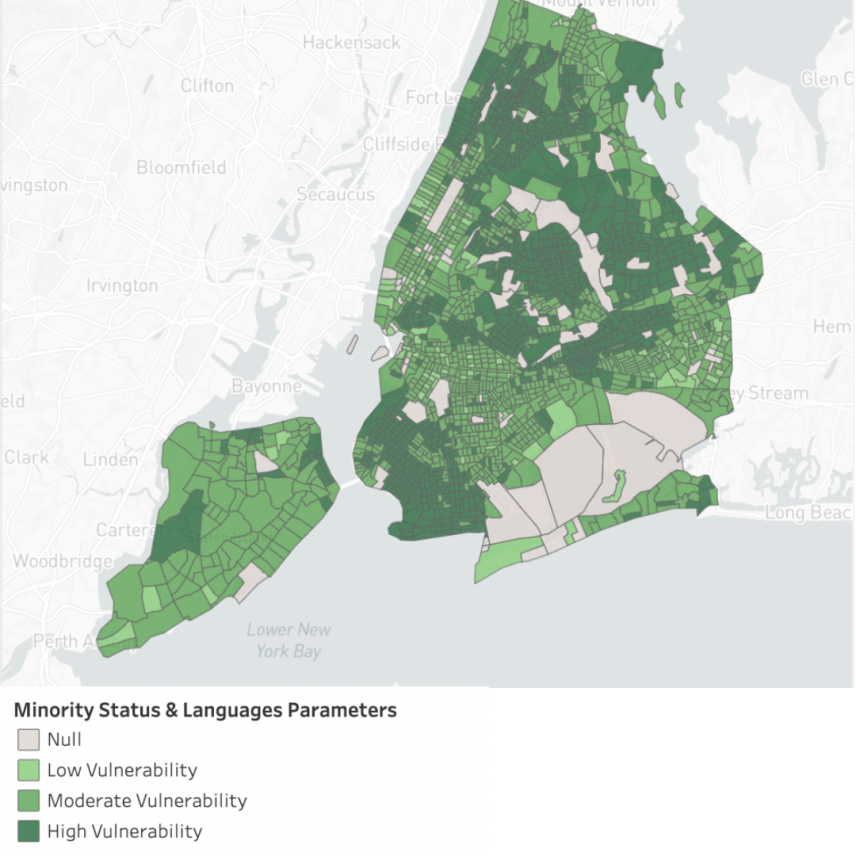NYU Wagner Urban Planning Capstone Team Develops Interactive Geospatial Tool

The New York City Department of Transportation (DOT) enlisted the help of a NYU Wagner Capstone team in 2020-21 to evaluate its project selection methodology through an equity lens. The project’s objective was to determine if its Better Buses projects are equitably distributed and assess whether DOT could do more to reach equity populations. The Master of Urban Planning (MUP) Capstone team comprised Rachel Brown, Ayesha Lilaoonwala, Caroline Morris, Maitri Pujara, and William Sklar, and was supervised by Adjunct Assistant Professor of Public Service Elizabeth Larsen.
In Fall 2021 with the support of their client, the team submitted an abstract of their research findings to the International Society of City and Regional Planners (ISOCARP), a member-led global association focused on sustainability and resiliency. ISOCARP invited the team to present its findings and selected the team to submit a full research paper, which they modified from their Capstone report. The outcome was publication of the team’s research paper entitled “Better Buses Equity Assessment Project” in the ISOCARP annual report in December 2021 and presentation of their findings at the ISOCARP 57th World Planning Congress under Track 1: Inclusiveness and Empowerment.
As part of the Capstone report, and featured in their ISOCARP article, the team developed an interactive geospatial tool in Tableau (an interactive data visualization software) to serve as a starting point for DOT to analyze its bus priority corridors against various equity factors—including minority status, socioeconomic status, and populations with disabilities. Publication with ISOCARP provided the students invaluable feedback on their research from professional planners around the world, with the possibility of replicating their work in other cities.
Capstone Project Background
DOT initiated its Better Buses Action Plan in 2019 to improve the speed of buses throughout NYC by 25% and increase the number of bus riders by the end of 2020. Although the COVID-19 crisis impacted these plans, in June 2020 DOT launched Better Buses Restart, a program that focuses on improving service for vulnerable populations and essential workers on an expedited timeline.
The Capstone team conducted a comparative analysis of equity initiatives in other US cities—San Francisco, Denver, Portland, and Oakland—then analyzed the needs of equitable populations and evaluated how DOT serves these populations through its project selection, planning, engagement, and evaluation practices.
Capstone Project Results
By assessing the existing conditions of transportation for equity populations in NYC, the Capstone team determined that people of color are much more reliant on the bus to commute to work and experience higher commute times than their white counterparts. Similar patterns were also observed in populations with disabilities. Analysis of the geographical data using the interactive geospatial tool helped determine the distribution of these equity populations in relation to existing bus lanes and provided pertinent insights on underserved regions. The equity population that stood out as being particularly underserved was communities of color: the percentage of people of color who live in census tracts with bus lanes, 62%, is lower than the citywide average of 68%.
The tool illustrates that existing bus lanes (but to be clear, not future priority corridors identified by DOT) are disproportionately located in neighborhoods with a lower population of people of color than the citywide average. However, while people are riding bus lanes outside their immediate neighborhoods, a bus priority improvement in a neighborhood that has a lower than average number of nonwhite residents often serves a high number of nonwhite riders, who are overrepresented in the bus system as a whole. The team discussed this complexity with DOT at length but, ultimately, measuring this factor was beyond the scope of the project.
To address the disparities and improve the overall inclusion of equity in the DOT bus programs, the team made the following recommendations:
- Give higher weight to equity measures within the project selection process
- Allocate a significant portion of bus priority funds to projects that disproportionately serve equity populations
- Use technology to engage with riders
- Establish a Transportation Equity Community Partnership Program
- Follow up with riders on implemented corridors
- Reevaluate the project selection criteria annually
Takeaways
Christopher Hrones, Director of Strategic Transit Initiatives at DOT and the Capstone project liaison, described how DOT is incorporating the Capstone team’s findings into ongoing bus priority initiatives as follows: “The DOT is doubling down on its focus on equity under this administration by implementing the 2021 NYC Streets Plan, which considers transportation equity throughout the City. As part of the Plan, we updated our methodology for choosing priority bus corridors in each borough, with equity measures comprising 25-30% of the weighted criteria. The Wagner Capstone Bus Equity Project underscored to us the need to explicitly consider equity metrics.”
NYU Wagner alumna Maitri Pujara, who spearheaded the development of the geospatial tool and presented the team’s research at ISOCARP, is currently working as an urban planner at Gensler, a global design and architecture firm. She plans to explore this project further, focusing on the application of the team’s analytical tool in bus transit planning equity in her hometown of Ahmedabad, India.
Learn more about the Capstone program and explore other past projects >>
